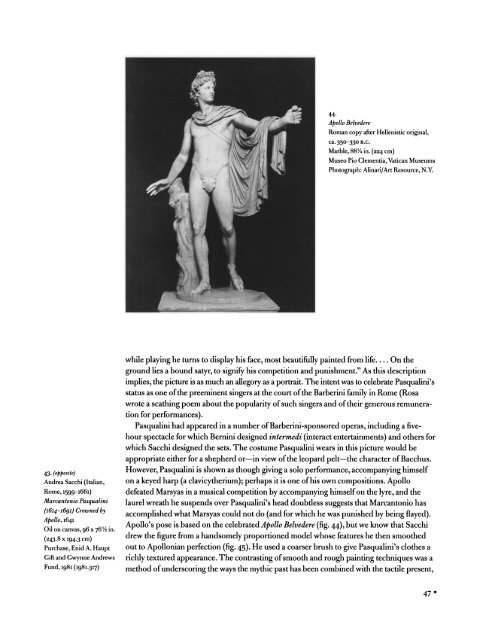GOING FOR BAROQUE Into the Bin - The Metropolitan Museum of Art
GOING FOR BAROQUE Into the Bin - The Metropolitan Museum of Art
GOING FOR BAROQUE Into the Bin - The Metropolitan Museum of Art
You also want an ePaper? Increase the reach of your titles
YUMPU automatically turns print PDFs into web optimized ePapers that Google loves.
44<br />
Apollo<br />
Belvedere<br />
Roman copy after Hellenistic<br />
ca. 350-330 b.c.<br />
original,<br />
Marble, 88 ?4 in. (224 cm)<br />
Museo Pi? Clementia, Vatican <strong>Museum</strong>s<br />
Photograph: Alinari/<strong>Art</strong> Resource, N.Y.<br />
43- (opposite)<br />
Andrea Sacchi<br />
(Italian,<br />
Rome, 1599-1661)<br />
Marcantonio<br />
Pasqualini<br />
(1614-16Q1)<br />
Crowned<br />
by<br />
Apollo, 1641<br />
Oil on canvas, 96<br />
x 76 V2 in.<br />
x<br />
(243.8 194.3 cm)<br />
Purchase, Enid A. Haupt<br />
Gift and Gwynne<br />
Andrews<br />
Fund, 1981 (1981.317)<br />
while<br />
playing<br />
he turns to display<br />
his face, most beautifully painted<br />
from life_On <strong>the</strong><br />
ground<br />
lies a bound satyr, to signify<br />
his<br />
competition<br />
and punishment."<br />
As this description<br />
implies,<br />
<strong>the</strong> picture<br />
is as much an as a allegory portrait. <strong>The</strong> intent was to celebrate<br />
Pasqualini's<br />
status as one <strong>of</strong> <strong>the</strong> preeminent singers<br />
at <strong>the</strong> court <strong>of</strong> <strong>the</strong> Barberini<br />
family<br />
in Rome<br />
(Rosa<br />
wrote a scathing poem about <strong>the</strong> popularity<br />
<strong>of</strong> such<br />
singers<br />
and <strong>of</strong> <strong>the</strong>ir generous<br />
remunera<br />
tion for performances).<br />
Pasqualini had<br />
appeared<br />
in a number <strong>of</strong> Barberini-sponsored operas,<br />
a<br />
including<br />
five<br />
hour<br />
spectacle<br />
for which Bernini<br />
designed<br />
intermedi<br />
(interact entertainments)<br />
and o<strong>the</strong>rs for<br />
which Sacchi<br />
designed<br />
<strong>the</strong> sets. <strong>The</strong> costume<br />
wears<br />
Pasqualini<br />
in this picture would be<br />
appropriate ei<strong>the</strong>r for a shepherd<br />
or?in view <strong>of</strong> <strong>the</strong> leopard pelt?<strong>the</strong><br />
character <strong>of</strong> Bacchus.<br />
However, Pasqualini<br />
is shown as a though giving<br />
solo performance, accompanying<br />
himself<br />
on a keyed harp (a clavicy<strong>the</strong>rium); perhaps<br />
it is one <strong>of</strong> his own<br />
compositions. Apollo<br />
defeated<br />
Marsyas<br />
in a musical<br />
competition by accompanying<br />
himself on <strong>the</strong> lyre,<br />
and <strong>the</strong><br />
laurel wreath he<br />
suspends<br />
over Pasqualini's head doubtless suggests that Marcantonio has<br />
accomplished what Marsyas<br />
could not do<br />
(and for which he was punished by being flayed).<br />
Apollo's pose is based on <strong>the</strong> celebrated<br />
Apollo Belvedere (fig. 44),<br />
but we know that Sacchi<br />
drew <strong>the</strong> figure<br />
from a handsomely proportioned<br />
model whose features he <strong>the</strong>n smoo<strong>the</strong>d<br />
out to Apollonian perfection (fig. 45).<br />
He used a coarser brush to give Pasqualini's clo<strong>the</strong>s a<br />
richly<br />
textured appearance. <strong>The</strong><br />
contrasting<br />
<strong>of</strong> smooth and was a<br />
rough painting techniques<br />
method <strong>of</strong> underscoring<br />
<strong>the</strong> ways <strong>the</strong> mythic past has been combined with <strong>the</strong> tactile present,<br />
47
















